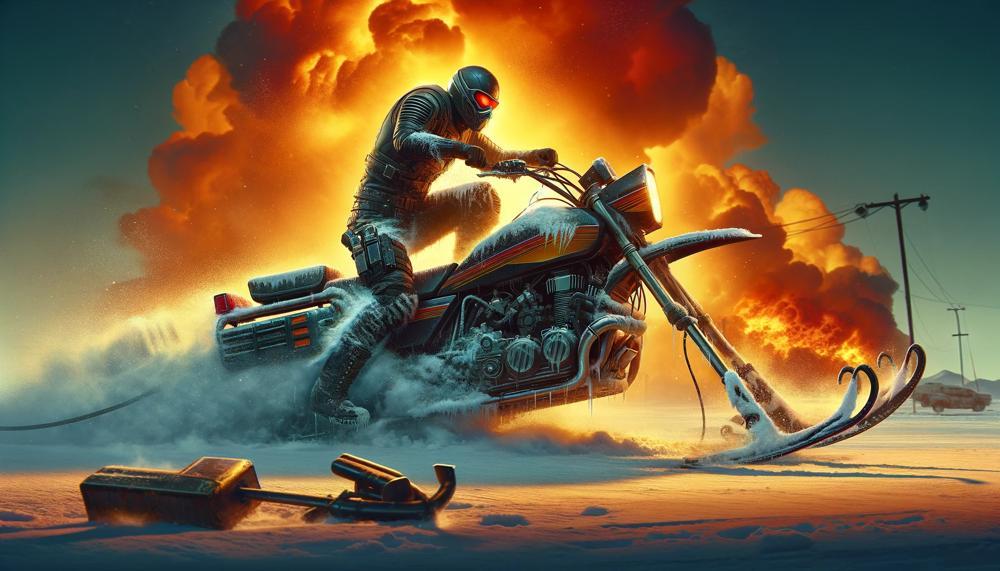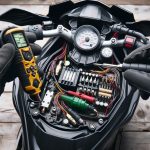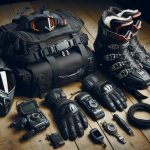As the winter chill sets in, snowmobilers everywhere are gearing up for a thrilling season on the snowy trails. But what happens when your trusty machine starts to overheat? It can quickly turn into a frustrating and potentially dangerous situation if not addressed properly.
As an experienced snowmobiler, I have encountered my fair share of overheating issues and have learned valuable lessons along the way.
In this blog post, I will delve into the reasons why your snowmobile may be overheating and provide tips on how to prevent it from happening.
So, Why My Snowmobile Is Overheating?
A snowmobile can overheat for many reasons, including:
Lack of snow
Liquid-cooled snowmobiles need snow to cool them down. This can be an issue at the beginning of the season, on hard-packed snow terrain, and especially on ice.
Deep snow
Deep powder sleds tend to overheat more quickly and more often on hard-pack, icy or low snow trail surfaces.
Other causes
Other common causes of overheating include:
- Bad electrical connections
- Faulty wiring
- Clogged exhaust pipe
- Airlock
- Dead water pump
If your snowmobile starts to overheat, you should immediately turn it off. You can also try these steps to cool it down:
- Drive in loose snow
- Check the coolant level and add coolant if it is low
- Stop the engine and allow it to cool down
- Ensure the radiator(s) (cooler) is clean and free of debris
Let’s get started.
Why Do Snowmobile Overheats?
Contents
Snowmobiles can overheat due to various factors, including riding on shallow or hard snow, lack of maintenance, and modifications.
To prevent overheating, regular maintenance is necessary, along with paying attention to warning signs and taking precautions while riding.
Riding on Shallow or Hard Snow:
- Ineffective cooling occurs when shallow or hard snow does not provide enough coverage of the heat exchanger to cool the coolant.
- To prevent this, it is recommended to ride in areas with deep and soft snow or add ice scratchers to keep the engine cool even on shallow or hard snow.
Lack of Maintenance:
- Regular maintenance is crucial in preventing snowmobile overheating.
- Follow the manufacturer’s recommendations for oil changes, coolant levels, and other maintenance tasks.
- Check for leaks and promptly replace any damaged or worn-out parts.
Modifications:
- Modifications can impact the cooling efficiency of a snowmobile.
- Consult with a professional before making any changes to ensure they do not cause overheating.
Fuel and Coolant Levels:
- Insufficient fuel or low coolant levels can lead to overheating.
- Before using the snowmobile, check and refill these levels if necessary.
Poor Snow Conditions:
- Riding in slushy or dirty snow can also cause overheating as it can clog the heat exchanger.
- Avoid these conditions whenever possible and regularly clean the heat exchanger.
To prevent costly repairs and damage, it’s essential to take necessary precautions and address any warning signs of overheating promptly. By following these tips, you can enjoy a smooth and pleasant snowmobiling experience without worrying about overheating.
Remember to always keep your snowmobile well-maintained and be aware of potential issues while riding.
Can You Ride a Snowmobile If It Overheats?
If your snowmobile starts to overheat while you’re riding it, there are some steps you can take to ensure your safety and prevent further damage to the vehicle.
- Stop Riding: As soon as you notice that your snowmobile is overheating, stop riding it immediately. Continuing to ride could cause serious harm to the engine and other components of the vehicle.
- Examine the Snowmobile: Once you’ve stopped, inspect the snowmobile to identify any potential causes of overheating. Look for leaks, low levels of coolant, and other signs of damage.
- Allow it to Cool Down: After stopping, give your snowmobile at least 30 minutes to cool down before attempting to ride it again. This will allow the engine to cool down and prevent any further damage.
- Check Oil and Coolant Levels: Once the vehicle has cooled down, check the oil and coolant levels to ensure they’re at the recommended levels. If they’re low, top them up before continuing your ride.
- Seek Professional Assistance: If your snowmobile continues to overheat despite following all precautions, it’s best to seek professional help. A mechanic or technician will be able to diagnose and fix any underlying issues causing the overheating.
So, while it’s technically possible to ride a snowmobile if it overheats, it’s not recommended. Overheating can cause significant damage to the vehicle and put your safety at risk. It’s crucial to regularly maintain your snowmobile and pay attention to warning signs of overheating to prevent any potential problems while riding.
Do Snowmobiles Overheat on Ice?
Yes, snowmobiles have the potential to overheat on ice if they are not adequately maintained and operated. Riding in shallow or hard snow conditions, particularly on warm days, can lead to overheating due to insufficient snow on the heat exchanger.
Even fan-cooled models are susceptible to overheating on icy terrains. However, this issue can be avoided through proper care and maintenance.
Understanding Snowmobile Cooling Systems:
Snowmobiles come with either liquid-cooled or fan-cooled engines, depending on the model. Liquid-cooled engines utilize a heat exchanger installed above the track that constantly throws snow onto it while rotating, effectively cooling down the engine.
On the other hand, fan-cooled engines rely on air for cooling and perform well in low temperatures but may still overheat on warmer days.
Common Causes of Overheating on Ice:

The most common cause of snowmobiles overheating on ice is riding in shallow or hard snow conditions. This results in inadequate cooling due to a lack of snow on the heat exchanger.
Other contributing factors include low coolant levels, debris accumulation in the cooling system, and modifications made to the engine without proper knowledge.
Signs of an Overheated Engine:
It is important for snowmobilers to be aware of warning signs that their engine may be overheating. These include warning lights on the dashboard, poor performance, and potential engine damage.
If any of these signs are noticed, it is best to stop immediately and allow the engine to cool down before further inspection.
How to Cool Down an Overheated Snowmobile:
In case of an overheated snowmobile engine, the first step is to stop riding and allow it to cool down. Once cooled, check the coolant level and inspect the cooling system for any leaks or debris buildup.
If unsure of how to do this, it is best to seek professional assistance. Continuing to ride an overheated snowmobile can cause further damage to the engine.
Preventing Overheating Issues:
To prevent snowmobiles from overheating on ice, proper maintenance is crucial, and modifications that could impact the cooling system should be avoided. Additionally, riders should pay attention to weather conditions and avoid riding in warm temperatures or on hard-packed snow.
Is Overheating Dangerous for Your Snowmobile?
Absolutely. If not addressed properly, it can cause serious damage. Here are some potential consequences of overheating and how to prevent them.
| Consequences of Overheating | Prevention |
| Stator and Voltage Regulator Failures | Regularly check fuel and coolant levels; consider adding extra fan or scratchers |
| Electrical Component Damage | Avoid modifications that could impact cooling system; pay attention to weather conditions |
| Engine Damage | Regularly check fuel and coolant levels; let the snowmobile sit for at least 30 minutes if it overheats during a long ride; consult a mechanic if overheating persists despite checking all possible causes |
What are the Problems Caused by Overheating?
Overheating can result in significant problems for both the snowmobile and its rider, ranging from engine damage to safety risks and costly repairs.
Engine Damage
An overheated snowmobile can cause severe damage to its engine, a vital component of the vehicle.
This can lead to the engine seizing or even causing a blown head gasket, which can be an expensive repair and may render the snowmobile unusable.
Safety Risks
An overheated snowmobile can also pose safety risks for the rider. If the engine overheats during a ride, it can suddenly shut down, leaving the rider stranded in hazardous conditions.
Additionally, an overheated engine can increase the risk of fire, putting both the rider and surrounding areas in danger.
Expensive Repairs
Ignoring overheating issues can ultimately result in costly repairs. Not only will you have to cover the cost of repairing or replacing damaged parts, but you may also need to pay for additional services, such as towing if your snowmobile breaks down far from home.
To avoid these potential consequences, it is crucial to regularly check for proper maintenance and promptly address any overheating issues.
Environmental Impact
Overheating can also have an environmental impact, especially in snowy areas where steam from melting snow can corrode electrical components and increase resistance in the system. This can lead to further damage and require additional repairs.
Impact on Other Riders
An overheated snowmobile can also affect other riders on a group ride. If one snowmobile overheats, it may delay or even cancel the trip for other riders who depend on that vehicle.
To prevent these potential consequences, it is essential to take proper precautions and promptly address any overheating issues. This includes regular maintenance checks and using high-quality parts that are less prone to overheating.
Additionally, adding extra cooling measures like fans or scratchers can help keep the engine cool during longer rides.
If the snowmobile continues to overheat despite these measures, it is best to consult a mechanic for proper maintenance to avoid further damage and ensure the safety of both the vehicle and its rider.
Causes of Snowmobile Overheating
| Common Causes of Snowmobile Overheating | Prevention Strategies |
| Inadequate Cooling in Shallow or Hard Snow Conditions | Choose a 4-Stroke Snowmobile for Improved Cooling in Challenging Conditions. |
| Insufficient Snow on the Heat Exchanger | Keep the Heat Exchanger Free from Debris and Regularly Monitor Coolant Levels. |
| Mechanical Issues with the Cooling System | Avoid Modifications that Can Disrupt the Cooling System. |
| Riding on Ice or Hard-Packed Trails | Immediately Stop the Engine if Overheating Occurs and Allow it to Cool Down Before Inspecting the Cooling System. |
| Mechanical Issues with the Cooling System | Install a Longer Snowflap or Secondary Heat Exchanger for Enhanced Cooling. |
In addition to these prevention strategies, it is essential to regularly maintain and inspect the snowmobile’s cooling system. This includes checking the coolant levels, cleaning the heat exchanger, and ensuring that all components are functioning correctly. It is also recommended to avoid modifications that can disrupt the cooling system, as they can lead to overheating.
What To Do If Your Snowmobile Overheats?
- Stop and shut off the engine: If you notice that your snowmobile is overheating, immediately come to a stop and turn off the engine.
- Let it cool down: Allow your snowmobile to cool down for at least 30-40 minutes before continuing with your ride or attempting any repairs.
- Check for leaks or damage: Once cooled down, inspect for any leaks or damage that could have caused the overheating. If you are unsure of what caused it, seek professional assistance.
- Seek professional help: If your snowmobile continues to overheat despite taking precautionary measures, it is best to seek professional help from a mechanic.
Conclusion
As winter comes, snowmobilers can’t wait to get out on the trails with their trusty machines. But what do you do if your sled gets too hot? If you don’t deal with it correctly, it can quickly become frustrating and even dangerous. There are many reasons why the engine in your snowmobile might be running hot, such as clogged air filters or not enough water.
Regular upkeep is very important to keep things from getting too hot. Simple things like making sure the coolant level stays high and the air filters are clean can go a long way toward keeping your ride running smoothly. But even with regular care, it’s still possible for things to get too hot on the paths.
It’s important to know what to do if your sled does get too hot. First, stop right away and give the engine time to cool down. Checking the fuel and coolant levels often and getting professional help if needed can stop damage from getting worse and save you a lot of money on fixes. A sled that is too hot can cause more than just technical problems. It can also be dangerous for the person and people nearby. It can also hurt the environment and make other riders on group trips uncomfortable.
Don’t let a sled that gets too hot ruin your winter fun. You can make sure you have a safe and fun snowmobile season by keeping up with upkeep chores and being aware of possible problems while going. Always keep an eye on your temperature gauge and act quickly if you see any red flags. The best way to avoid problems is to stop them before they happen.






